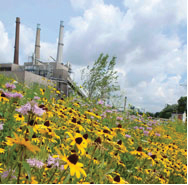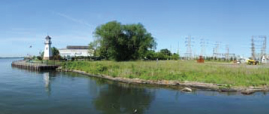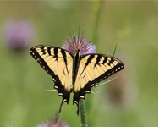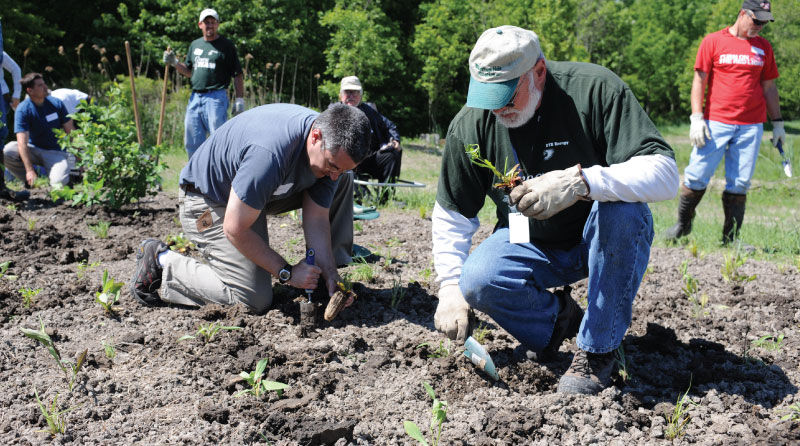Habitats
As one of the largest landowners in Michigan, DTE Energy maintains thousands of acres of land as living space for hundreds of species of birds, mammals, fish and insects. Additionally, many of our facilities have environmental policies that help nurture wild habitat on their grounds.
A focus of our wildlife program is providing “stopover sites” for migratory birds to rest and refuel. Many DTE Energy facilities are located along the important Atlantic and Mississippi flyways, the routes Great Lakes birds use every spring and fall. By planting a variety of native trees, shrubs and perennials that attract insects and produce seeds and berries, DTE Energy facilities put out the “welcome mat” for birds traversing the Lake Huron to Lake Erie migratory corridor.
Improving Habitat
Prairie
 Originally, the Great Lakes basin was a combination of arboreal forest and grasslands. DTE Energy employees have worked with our environmental partners to restore prairies at company-owned sites throughout Michigan, now home to mammals, insects, reptiles and birds.
Originally, the Great Lakes basin was a combination of arboreal forest and grasslands. DTE Energy employees have worked with our environmental partners to restore prairies at company-owned sites throughout Michigan, now home to mammals, insects, reptiles and birds.
One example of this prairie reclamation is our Monroe Power Plant. Featuring over 800 acres of prairie and wetland habitat, it has been designated as a Conservation Education Site (CES) for serving as an outdoor laboratory for the Charles and June Knabusch Mathematics & Science Center. Local middle and high school students perform projects and research at the property, including land mapping as well as math, science and environmental studies.
Wetlands
These essential landscapes help regulate water levels within watersheds, improve water quality, reduce flood and storm damages, plus provide important fish and wildlife habitat. They also support hunting, fishing and other recreational activities.
Many wetlands have been preserved from development because of their proximity to DTE Energy facilities. In other instances, we have restored wetlands that had been drained for agriculture, or created wetlands to replace those lost during construction or expansion of our facilities.
Shorelines
 Two DTE Electric facilities have conducted projects to restore sections of shoreline banked with barren concrete to a more natural condition. Using an approach called “soft shore engineering,” these areas now slope naturally to the water's edge and are planted with beautiful native grasses and wildflowers, creating habitat for fish, birds and land animals.
Two DTE Electric facilities have conducted projects to restore sections of shoreline banked with barren concrete to a more natural condition. Using an approach called “soft shore engineering,” these areas now slope naturally to the water's edge and are planted with beautiful native grasses and wildflowers, creating habitat for fish, birds and land animals.
The River Rouge Power Plant sits along the Detroit River in the middle of one of the region’s most industrialized areas. DTE Energy staff and partners removed 850 cubic yards of concrete riprap, rebar and gravel along 200 feet the river’s edge. They reshaped the shoreline, installed erosion control fabric and added native plants on land and in the water to create habitat for fish and other wildlife species. We similarly enhanced a 300-foot section of the River Raisin shoreline at the Monroe Power Plant.
The DTE Energy Care Force participates in various river cleanups each year, from the Detroit River to the rivers of the Rouge watershed and beyond.
Pollinator Gardens
 Many DTE Energy facilities, including our downtown Detroit headquarters complex, feature gardens of drought-tolerant native plants to attract pollinators, such as hummingbirds, butterflies and bees. Employees and visitors alike can enjoy the color of the flowers and their iridescent visitors.
Many DTE Energy facilities, including our downtown Detroit headquarters complex, feature gardens of drought-tolerant native plants to attract pollinators, such as hummingbirds, butterflies and bees. Employees and visitors alike can enjoy the color of the flowers and their iridescent visitors.
Nets
DTE Energy is doing its part to protect animals and plants in Michigan. Employees, their children and local Scout troops have built and installed dozens of nesting structures at DTE Energy facilities and other surrounding locations.
Each species has unique requirements for shelter, resulting in the construction of specific nest boxes for wood ducks, American kestrels, peregrine falcons and Eastern bluebirds, platforms for ospreys and bald eagles, houses for bats, tubes for mallards and brush piles for small mammals. We have also built breeding habitat for the rare common tern, which nests on the ground in sand and gravel.
